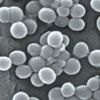- Clinical Technology
- Adult Immunization
- Hepatology
- Pediatric Immunization
- Screening
- Psychiatry
- Allergy
- Women's Health
- Cardiology
- Pediatrics
- Dermatology
- Endocrinology
- Pain Management
- Gastroenterology
- Infectious Disease
- Obesity Medicine
- Rheumatology
- Nephrology
- Neurology
- Pulmonology
Emerging Infections:What You Need to Know, Part 1
Within the past 7 years, the incidence of methicillin-resistant Staphylococcus aureus (MRSA) and Clostridium difficile infections has significantly increased. Risk factors for MRSA infection include previous antibiotic therapy and living arrangements such as prisons or military barracks that involve close, frequent contact with infected persons. Treat stable patients with MRSA skin infections with oral antibiotics in addition to incision and drainage; hospitalization and intravenous antibiotics are recommended for patients whose condition is unstable or who are unlikely to adhere to an oral regimen. A new strain of C difficile, BI/NAP1, has been associated with recurrent infection; more severe disease that mandates urgent colectomy; and dramatically higher mortality in vulnerable populations, such as older adults. Although oral metronidazole has been the mainstay of treatment of C difficile infection, oral vancomycin may be slightly more effective in patients with severe disease.
In the developing world, infectious diseases remain major threats to health. In wealthier countries, complacency about infections has been shaken by 4 phenomena:
•Antibiotic-resistant bacteria.
•Fear of bioterrorism.
•The threat of pandemic influenza.
•Potentially dangerous new microbes.
The biosphere offers ample opportunities for extant microbes or novel variants to join the list of human pathogens. New infections pose new challenges because of limited immunological experience, unusual modes of transmission, and lack of effective therapeutic interventions. No one can predict the next outbreak; therefore, we need to use all our modern tools to anticipate and prepare for all eventualities. The CDC Emergency Preparedness & Response Web site (www.bt.cdc.gov) is an excellent source that lists all infectious agents, diseases, and other threats. The index has up-to-date guidelines on diagnosis, laboratory testing, infection control, treatment, and vaccination.
In this 2-part article, I will review some of the current emerging infectious agents and the epidemiological and clinical clues to their diagnosis. I will also highlight the resources available for physicians when confronted with such a threat. Here the focus is on antibiotic-resistant pathogens; in a coming issue, I will discuss bio- terrorism, pandemic influenza, and emerging exotic infections.

Figure 1

Figure 2
METHICILLIN-RESISTANT STAPHYLOCOCCUS AUREUS
Beginning in 2001, the prevalence of skin and soft tissue infections caused by methicillin-resistant Staphylococcus aureus (MRSA) greatly increased.1 Unlike previous MRSA infections, these infections were more severe and recurrent and affected persons who were not previously ill and who had not recently been in a hospital or nursing home-eg, active and healthy children,2 soldiers,3 and athletes.4
A thorough analysis of the MRSA strains, sometimes called community-acquired MRSA (CA-MRSA), showed that they are closely related and unlike the traditional MRSA isolates found in hospitalized patients (Figure 1). The most common CA-MRSA strain, USA-300, contains a significant number of toxin genes, as well as an adherence property previously associated with other species of staphylococci (including Staphylococcus epidermidis-a common skin bacterium).5 This adherence property might account for the ease of transmission from person to person, while the toxins may explain the severity of illness (including systemic illness that can lead to pneumonia or death).
Epidemiological analysis showed that the acquisition of CA-MRSA is related to both exposure opportunities and diminution of host protection. Exposure to the organism was found among close, frequent contacts living in various domiciliary arrangements, such as dormitories, prisons, and military barracks. Transmission may have been abetted by poor hygiene (eg, the sharing of towels and personal grooming supplies that are colonized with these adherent strains).
Reduced host defenses are a more complex risk factor. However, there is a striking association between previous antibiotic therapy and new infections with MRSA. In an outbreak of CA-MRSA skin infections among professional football players, the mean number of antibiotic prescriptions was 2.6 per year.4 In military recruits who were colonized on entry into boot camp, any antibiotic use during the previous 6 months was a risk factor for nasal colonization with CA-MRSA (P = .03).3 Nasal colonization resolved within weeks; however, subsequent infections developed in 38% of those with nasal colonization, compared with 3% of those without colonization.
The difference between classic S aureus infection and MRSA infection can be subtle. MRSA strains have a propensity to lead to deeper soft tissue infections (that involve the muscle, for instance) as well as pneumonia. When confined to the skin, the infections can be difficult to distinguish (Figure 2).
In the past, the classic clinical picture of a staphylococcal infection was an acutely ill patient with a localized skin lesion, such as an abscess, or a more diffuse skin infection, such as cellulitis. These infections would respond to oral antibiotics and drainage of any pus collections. In fact, incision and drainage was thought to constitute adequate management of an S aureus skin abscess.6 Incision and drainage is still an important component of treatment, although close follow-up is needed to assess the response to drainage and to look for recurrence. Patients who have lesions that are identified early and treated medically or who have small lesions that are managed expectantly can often avoid incision and drainage.
In addition to incision and drainage, I recommend oral antibiotics for stable patients and hospitalization along with intravenous antibiotic therapy for patients whose condition is unstable or who are unlikely to adhere to an oral regimen. For oral therapy, the usual choices include trimethoprim/ sulfamethoxazole, clindamycin, doxycycline or minocycline (sometimes with rifampin), and linezolid.

Figure 3

Figure 4
CLOSTRIDIUM DIFFICILE
Antibiotic-associated diarrhea and colitis have long been a major concern for clinicians who care for hospitalized patients (Figure 3). Studies from the mid 1980s onward have shown that the most severe kinds of hospital-acquired colitis are related to colonization by the toxin-producing organism Clostridium difficile (Figure 4). This bacterium is almost uniformly associated with previous antibiotic therapy, without which the risk of C difficile colitis is very low. Antibiotics that suppress the normal anaerobic flora in the gut-without similarly suppressing C difficile-predispose patients to C difficile-associated diarrhea (CDAD). Such antibiotics include clindamycin and various penicillins and cephalosporins.
In 2000, the incidence of CDAD surged. This increase was worrisome because it was accompanied by a higher-than-usual mortality, and cases occurred in patients who had taken antibiotics not typically associated with CDAD or who had not received antibiotics. These new cases were also difficult to treat effectively without recurrence. Furthermore, the severity of the disease was associated with a greater need for urgent colectomy7 and dramatically higher mortality in vulnerable populations, such as older adults.
A new strain of C difficile, BI/ NAP1, was suspected, based on in vitro testing. Most isolates of this strain are highly fluoroquinolone-resistant, which may account for the high risk of CDAD in patients who receive this class of drug. Tests showed extremely high levels of the usual C difficile toxins as a result of derepression of the toxin gene as well as a binary toxin gene complex that had previously rarely been found in C difficile. The role of the binary toxin has not been completely illuminated. Isolates of this BI/NAP1 strain have been found predominantly in Canada and the United States (in the northeast and southeast quadrants and on the West Coast).8 The precise origin of the new strain is unknown. The clinical manifestations of infection with the new strain overlap with the classic symptoms of C difficile infection (fever, diarrhea, abdominal pain) and laboratory test results (increased white blood cell count, positive C difficile toxin assays).
Treatment of infection with these new strains is the same as that of classic C difficile infection, but clearly there is a need for vigilance and an early change of therapy (including possibly surgery) for slow responders. Although oral metronidazole alone has been the mainstay of treatment of C difficile infection, oral vancomycin may be slightly more effective for patients with severe disease.9 The treatment of patients who cannot tolerate oral medications is difficult; vancomycin enemas have been suggested.
Recommended preventive strategies include:
•Limiting antibiotic use (especially clindamycin, cephalosporins, and fluoroquinolones).
•Patient isolation.
•Zealous hand hygiene, preferably hand washing, because alcohol-based hand hygiene products are less effective against spore-forming organisms, such as clostridia.
•Environmental cleaning.
OTHER RESISTANT BACTERIA
Meningococcal resistance to penicillin is still very rare, and pneumococcal resistance to penicillin is not yet a critical clinical problem for patients with respiratory tract infections. However, unexpected resistance can result from unusual selection pressures.
A Dutch study reported an outbreak of lymphogranuloma venereum, a chlamydial sexually transmitted disease, that occurred mostly in HIV-1- infected men who had sex with men.10 Eventually, other cases were found outside the initial Rotterdam cohort, and some have appeared in the United States. Azithromycin is preferentially used to treat lymphogranuloma venereum and sometimes even syphilis; however, this drug has had substantial exposure among men with advanced HIV-1 infection because it is a preventive agent for Mycobacterium avium complex (MAC) infection.
A strain of Treponema pallidum that is resistant to macrolides (including azithromycin) has been identified, and the resistance phenotype is thought to be the result of a specific, new mutation in the 23S ribosomal RNA gene.11 Researchers theorize this ribosomal mutation is favored in populations that are heavily exposed to macrolides (for pneumonia, MAC infection prophylaxis, and chlamydial genital infection) and that are at high risk for syphilis. Variants of this azithromycin-resistant strain have been found on the West Coast of the United States, in Maryland, and in Ireland. Azithromycin should be used to treat syphilis only in areas where it is likely to be effective (based on regional resistance data) and in patients who can be monitored for possible failure.
References:
REFERENCES:
1.
Hawkes M, Barton M, Conly J, et al. Community-associated MRSA: superbug at our doorstep.
CMAJ
. 2007;176:54-56.
2.
Herold B, Immergluck LC, Maranan MC, et al.
Community-acquired methicillin-resistant
Staphylococcus aureus
in children with no identified predisposing risk.
JAMA.
1998;279:593-598.
3.
Ellis MW, Hospenthal DR, Dooley DP, et al. Natural history of community acquired methicillin-resistant
Staphylococcus aureus
colonization and infection in soldiers.
Clin Infect Dis.
2004;39:971-979.
4.
Kazakova SV, Hageman JC, Matava M, et al. A clone of methicillin-resistant
Staphylococcus aureus
among professional football players.
N Engl J Med
. 2005;352:468-475.
5.
Liera JL, Levy RC. Treatment of cutaneous abscess: a double-blind clinical study.
Ann Emerg Med.
1985;15:57-61.
6.
Holden MT, Feil EJ, Lindsay JA, et al. Complete genomes of two clinical
Staphylococcus aureus
strains: evidence for the rapid evolution of virulence and drug resistance.
Proc Natl Acad Sci U S A.
2004;101: 9786-9791.
7.
Loo VG, Poirier L, Miller MA, et al. A predominantly clonal multi-institutional outbreak of
Clostridium difficile
-associated diarrhea with high morbidity
and mortality.
N Engl J Med.
2005;353:2442-2449.
8.
McDonald, LC, Killgore GE, Thompson A, et al. An epidemic, toxin gene-variant strain of
Clostridium difficile
.
N Engl J Med.
2005;353:2433-2441.
9.
Zar FA, Bakkanagari SR, Moorthi KM, Davis MB. A comparison of vancomycin and metronidazole for the treatment of
Clostridium difficile
-associated diarrhea, stratified by disease severity.
Clin Infect Dis.
2007;45:302-307.
10.
Nieuwenhuis RF, Ossewaarde JM, Gotz HM, et al. Resurgence of lymphogranuloma venereum in Western Europe: an outbreak of
Chlamydia trachomatis
serovar L2 proctitis in The Netherlands among men who have sex with men.
Clin Infect Dis
. 2004; 39:996-1003.
11.
Lukehart SA, Godornes C, Molini BJ, et al. Macrolide resistance in
Treponema pallidum
in the United States and Ireland.
N Engl J Med.
2004;351: 154-158.
EVIDENCE-BASED MEDICINE:
•Liera JL, Levy RC. Treatment of cutaneous abscess: a double-blind clinical study.
Ann Emerg Med.
1985;15:57-61.
•Zar FA, Bakkanagari SR, Moorthi KM, Davis MB. A comparison of vancomycin and metronidazole for the treatment of
Clostridium difficile
-associated diarrhea, stratified by disease severity.
Clin Infect Dis.
2007;45:302-307.
•Centers for Disease Control and Prevention. Emergency Preparedness & Response Web site. Available at:
www.bt.cdc.gov
. Accessed September 5, 2007.
GUIDELINES:
•Centers for Disease Control and Prevention.Emergency Preparedness & Response Web site.Available at:
http://www.bt.cdc.gov
. AccessedSeptember 5, 2007.
